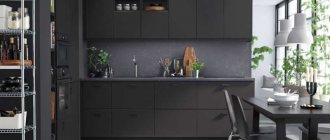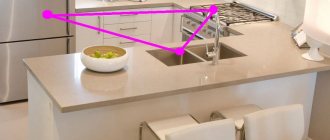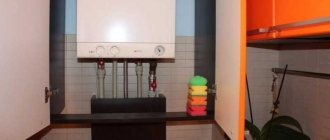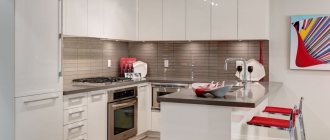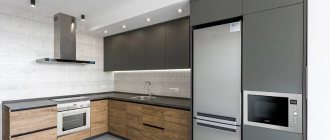Food storage area
The refrigerator is quite a tall object, because of this it is not possible to place it outside the kitchen corners, since it will tear the kitchen space into small areas, which in itself is ugly and inconvenient.
When installing it, you should take into account the direction in which the door opens; it should not block free space and interfere with movement. Today, refrigerator manufacturers have taken this nuance into account and offer customers models with removable doors; if necessary, they can be moved to the other side. Related links: Why Japanese curtains have become so popular in apartment interiors
Designer recommendations
When two housewives are cooking in the kitchen, you should be very careful when planning the work triangle. Their trajectory of movement will intersect if the scheme is thought out incorrectly. This will not only be uncomfortable, but also dangerous, given that in the kitchen you have to deal with boiling water and hot oil.
An isosceles triangle is considered ideal, but it is difficult to implement such an idea in a small kitchen. Here it would be more appropriate to arrange the furniture in one line.
An island kitchen requires as much free space as possible. For comfortable use of space around the island there must be a place with a radius of at least 1.2 meters.
It is more convenient to place the cooking and washing areas nearby so that there is no need to cross the aisle with dangerous hot pots and a kettle. When the island is large, it is worth installing a sink with a stove. It can also be used to store kitchen utensils or to organize seating.
What kind of kitchen do you have?
How to correctly place the vertices of a triangle?
It is believed that the optimal working space in the kitchen should be 5-7 m2.
If the triangle is significantly larger, this leads to an increase in the distance between its vertices, which ultimately complicates the implementation of basic tasks. Even an extra couple of steps in one direction is a significant additional load. This will become especially noticeable over long periods of time - a few extra steps taken several times a day quickly turn into kilometers.
This was one of the main considerations of German scientists when they worked to create an effective concept. They were faced with the task of minimizing the amount of wasted resources, and the proposed triangle was fully consistent with this.
If the area of space between three key points is less than 5 m2, the area will turn out to be very cramped and uncomfortable. Yes, in this case access to each element will be as fast as possible. But when at least one more person appears in the kitchen, it will immediately cause discomfort and interfere with work.
Basic principles of ergonomics in the kitchen when planning
The term “ergonomics” itself came to us from the Greek language; literally translated, it consists of two derivatives “ergon” - work, and “nomos” - law. The term denotes a whole section of scientific research related to the study of the work of the human body and the relationship between labor productivity and energy expenditure.
Correct ergonomics in the kitchen is ensured through proper design and arrangement of furniture in such a way that the housewife spends a minimum of effort when working. Studies have shown that following the basic principles of ergonomics in the kitchen will save up to 30% of your time and make your work easier by 50%. Mainly due to compliance with the basic rule of the “working triangle” and compliance with the standards of kitchen furniture with proper placement of household appliances.
Neufert and ergonomics in the kitchen, the triangle rule
The term “work triangle”, familiar to many, was introduced by the German architect Neufert. He proposed optimizing movement between three main centers of activity: the sink, the refrigerator and the stove. Ideally, all three centers should be located at the vertices of an equilateral triangle, then the cost of moving the housewife will be minimal.
But in reality everything turned out to be somewhat more complicated. The layout of small kitchens and large ones, with a regular and elongated shape, may differ. However, the general principles of ergonomics in the kitchen remain the same in all cases:
- The sink is the main center of activity. According to research, the owner spends approximately 50% of all time near her. Therefore, its position, the location of adjacent modules with drawers and wall cabinets with drying should be as convenient as possible.
- The slab is the second most important center of activity. It is advisable to place it at a distance of 800-1200 mm from the sink, in large kitchens - up to 1800 mm. Optimally – as close to the dining area as possible.
- It is better to place the refrigerator, freezer, and other modules used for storing food in the corner of the kitchen so as not to “tear” the work surfaces into non-functional areas. With proper ergonomics in the kitchen, the refrigerator should be no further than 1200mm from the stove and 1800mm from the sink. But with different kitchen layouts, this distance can either decrease or increase.
General ergonomics of the kitchen space depending on the layout of the unit
Here are the TOP 5 useful tips on how to maintain proper ergonomics in the kitchen:
When designing a kitchen set, consider your own physical parameters. So, the height of the working surface is determined by the arms bent at right angles at the elbows: there should be about 150mm between them and the working surface. And you will forget about back pain when cooking for a long time. Also, the maximum shelf level in wall cabinets should be at the distance of your outstretched arm minus 250mm. Make sure there is sufficient lighting on the work surface. Use spotlights for this above the main areas - sink, stove, food processing area. Also plan sockets for connecting household appliances; they should not “go” into the sink and stove areas, this is dangerous. Experience shows that the main injury and fire hazards arise near the stove. It should not be located in the aisle, near a pencil case, refrigerator or window with a curtain. The distance from the hob to the hood must be at least 700mm for an electric stove and 800mm for a gas stove. With proper ergonomics in the kitchen, the washing machine and dishwasher are located as close as possible to the sink and communications with drainage and water supply. Take care about the placement of sockets for them - they should not be located exactly behind the appliances
In this case, in the event of a breakdown or emergency, you will have to pull them out first to turn them off, and this is not the best option. The quality of fittings, pull-out and lifting mechanisms is also important so that the ergonomics in the kitchen correspond to a high level of comfort. Doors should open without noise or creaking, just like roll-out and pull-out storage systems. The ease of operation and service life of kitchen furniture as a whole depends on this.
If possible, install door closers on your kitchen cabinets; there are plenty of budget options.
The ease of operation and service life of kitchen furniture as a whole depends on this. If possible, install door closers on your kitchen cabinets; there are plenty of budget options.
Types of Kitchen Layouts
How to determine the working triangle in the kitchen, how to correctly arrange its vertices and maintain the required distance if the space has a complex layout? Experts identify several types of kitchen planning solutions :
- Linear - a layout in which the kitchen set is located in a row. The work triangle is expanded here, and you have to move along one line. The refrigerator, stove and sink are located sequentially one after another. From an ergonomic point of view, it is better to install the sink in the center, between the stove and the refrigerator. This will ensure convenient access to products. Most often, the single-row layout option is found in small or narrow kitchens.
- Corner - a layout in which the room is divided into several zones: working and dining. One side is located along the wall, the other is perpendicular to it. The layout fits perfectly into square and rectangular rooms. It turns out to be a truly “triangular” kitchen. To correctly position the vertices of a triangle, you should adhere to several rules. The place for the sink is in the corner, on the left and right there are small sections of the countertop. There is a stove along one wall with a sink, and a refrigerator against the other wall. With this arrangement, it is convenient to store kitchen utensils in wall cabinets above the sink.
- U-shaped kitchen - layout with three rows of furniture. It is convenient to place the sink in the middle of them, along with the work surface. The remaining functional zones are located on parallel sides. You can also place storage space there. An important point is lighting. There should be enough natural light. Often there are options with a washing area near the window. The layout is suitable for spacious rooms. The central part of the headset should be installed against a wall from two to four meters in length. Two opposing blocks should be placed two or three meters apart.
- Parallel - layout with two rows of furniture. In such a kitchen, it is optimal to divide the triangle into both sides. Place the sink and refrigerator on one side, the stove on the opposite side. The layout is suitable for wide and walk-through kitchens. If the room is spacious, then storage systems and cabinets for small equipment are installed on one side. The disadvantage of a two-row kitchen is the difficulty of placing a dining area.
- Island - layout with an additional block in the center of the room. A kitchen with an island is the dream of many housewives; it is comfortable to be in and cook in. The island can become one of the vertices of the working triangle. You can place a sink, stove or work surface there. The remaining zones are in the headset. The cabinet allows you to create an ergonomic triangle that meets the standards. It is worth keeping in mind that the kitchen area must be at least 20 square meters. m, since the island visually reduces the space.
- Semicircular - layout with an island of a non-standard shape. The same principle works here as in an island kitchen: one zone is on the island, the other two are on the cabinet. The difference is in the shape of one of the parts of the headset. It is located in an arc. The layout option will fit well into a spacious long room.
It is necessary to take into account the given recommendations when arranging the kitchen. The ergonomics of the workspace directly depends on the arrangement of the elements of the kitchen unit .
Adding ergonomics - a sofa with a storage box and a shelf
Current design and interior of modern kitchens
Kitchen planning. Work triangle rule: refrigerator-sink-stove
Comfort in the kitchen depends on many factors: ergonomics and size of the room, the presence of household appliances, good lighting. But the most important thing is to follow the rule of the working triangle - refrigerator-sink-stove.
Many of us, when renovating the kitchen ourselves without the involvement of designers, arrange furniture and household appliances according to our taste and taking into account the dimensions of the room. But in addition to the laws of ergonomics, there is a specific rule for the arrangement of the three main elements of the kitchen: the refrigerator, stove and sink. Their correct location optimizes the work of the housewife in the kitchen.
The working triangle rule is based on dividing the kitchen into several main zones:
storage: refrigerator,
food preparation: washing and cutting surface,
cooking: stove.
These functional zones should be located at the vertices of an equilateral triangle. And the distance between them should not exceed two arm's length distances. It is also not recommended to combine these zones, that is, to place them next to each other, for example, a sink and a stove, or a refrigerator and a stove. There must be a gap between them, at least 60 centimeters of the tabletop.
It is best to place the sink in the center of the work triangle, as it is the main center of activity. The housewife spends almost 50% of her total time in the kitchen near the sink. It is advisable to place the refrigerator in the corner of the room. So it will not clutter up the interior with its size. And the stove should be positioned so that it cannot be accidentally touched, and there should be 40 centimeters of working surface on both sides of the stove.
The working triangle rule arose as a result of thread research conducted in the twenties of the 20th century in Germany. This study aimed to study the amount of time and distance traveled by a housewife when preparing a particular dish. As a result, the optimal placement of kitchen elements (refrigerator, stove, sink) was determined, in which it is possible to prepare a dish in the shortest possible time, traveling the minimum distance. The study found that through smart kitchen planning, a housewife can save up to 60% of travel time and 27% of time.
There are several main types of kitchen layout and in each of them the working triangle has its own characteristics:
linear kitchen (single-row): this type of layout is found in small kitchens. The work triangle is placed in one line: the sink is located between the refrigerator and the stove. It is necessary to place a work table 60 cm wide between the sink and the stove.
two-row kitchen - this layout is typical for elongated, narrow rooms, and the furniture is arranged in two rows. In this case, the zones of the working triangle must be arranged in two lines. There is a sink and stove in one row and a refrigerator in the other. But it must be remembered that with such a layout, the distance between two rows of kitchen furniture should be at least 120 centimeters.
An L-shaped kitchen is typical for small square spaces. With this layout, the sink is located in the middle, between the refrigerator and the stove. This layout allows you to isolate the kitchen triangle and leave room for a dining area.
U-shaped kitchen: furniture is arranged in a U shape along three walls. The sink is located in the middle row, and the stove and refrigerator are in opposite sections, the width of the passage between which should be between 120 and 280 cm.
island kitchen is possible for large kitchens with an area of 20 sq.m. There is a sink or stove on the island. A more convenient option is a peninsular kitchen, which uses up less free space and creates more storage space.
The kitchen is one of the most important rooms in the house. Therefore, its layout should be as convenient as possible. The work triangle rule is not an axiom. If you don't know how to use this rule, then find your own combination by trying several options from your own experience.
How to plan the main triangle in your kitchen
Kitchen planning is an individual matter, but a few tips will help you with this.
1. Think about what you weren't happy with in your previous kitchen. Focus on the inconveniences that constantly bothered you. Try to plan the kitchen work triangle taking these inconveniences into account and eliminate them in the new layout.
2. Planning your kitchen triangle depends on the shape and size of your kitchen. Start planning with drawings. Measure the dimensions of the kitchen. On the sketch, “arrange” the planned furniture in several options. Imagine how you will move around the kitchen while preparing food. Eliminate unnecessary pieces of furniture such as tables, chairs, counters, and island cabinets from traffic directions.
3. Don't forget about the additional triangle elements. There should be a work surface between the sink and the stove for cutting food. By the way, such a surface will technologically separate the stove and the sink, and it should be at least 60 cm. Think about how and where the refrigerator opens, this is especially important in small kitchens. 4. In single-row kitchens, the work triangle loses its meaning. The sequence of arrangement of the working elements of the kitchen is important here. The ideal option is if there is a sink behind the refrigerator, and behind it across the work table there is a stove.
5. Don't forget about places to store cooking utensils. It can hardly be considered effective to go to the next room to get pots and pans. 6. Pay special attention to the accuracy of measurements. Sometimes a couple of centimeters can affect the arrangement of furniture, and it will be a shame if the purchased kitchen does not fit into your plan. Again, this is important for small and not large kitchens. When taking measurements, pay attention to the protruding window sill, especially if you are planning to install plastic windows. A kitchen apron made of tiles will give a small plus to the wall; this is up to 2 cm for tile adhesive and tiles and up to 1 cm for leveling the wall (if required). 7. And lastly, despite all the advice that you can read, remember, you are making the kitchen for yourself and your experience and practice should be your main advisor.
Especially for the site: “Do-it-yourself kitchen renovation“
Current or outdated?
Many people believe that today there is no need for a kitchen triangle. The model is already outdated, and new solutions are coming to replace it, for example, open-plan kitchens. They consist of a separate work desk, a bar instead of the usual dining area and a sink, for which a separate area with a table and work surface is allocated.
A broken nail is no problem: tips for treating nails at home
“Olga” from the series of the same name: the tragic fate of actress Yana Troyanova
When toothpaste is harmful to children: permissible age doses
In recent years, the kitchen triangle model has lost its former popularity because it does not work in every kitchen. In many cases, there is simply not enough space for installation, especially in a galley-type kitchen.
Designers are gradually moving away from this layout. Although older houses tend to still stick to the triangular design, modern buildings are much different.
Electrical panel diagram
When installing the panel and electrical wiring, you should draw up the diagram correctly. Such work is usually entrusted to a specialist engineer. However, subject to certain principles, it is performed independently. The wiring diagram and panel must be accurate. This will ensure safe operation of the system.
One of the simplest is the single-line diagram of the shield. You can understand it quite quickly. The name “single-line” appeared because in such a diagram one line denotes a group of wires at once, and not individual electrical cables. How many wires there are are shown using slashes. Below the diagram shows the power, cable type and consumer lines.
To protect the electrical system from overvoltage, circuit breakers are used to open the electrical network under load. It is not recommended to use them everywhere, since they react quite painfully to shutdown under load. It is better to install electric machines.
To understand the connection diagram of the electrical panel with all current consumers, you should look at its more attractive option. This diagram displays all electrical devices and conductors. The electrical panel diagram must meet the requirements of GOST.
Planning Features
Let's look at how you can organize the golden triangle with different furniture layouts in the kitchen in modern conditions.
Kitchen with straight linear shape
A linear or one-row layout involves placing a kitchen unit along the length of one wall - in this case, the triangle becomes one line on which a refrigerator, hob and sink are placed one after the other. Often, a similar plan is chosen for small or not very wide and long kitchens. When the area is actually small, it is more convenient to place the sink between the panel and the refrigerator.
If you choose a place for it, it is advisable to install the dishwasher near the sink so as not to complicate the procedure for loading dirty kitchen utensils. It is better not to use a linear layout for large kitchens, since the distances between zones will increase, and moving between them will be completely uncomfortable and energy-consuming.
Corner kitchen
A corner kitchen can be L-shaped or L-shaped, it all depends on the kitchen unit. When locating furniture in this way, follow several recommendations for the location of the triangle: leave the sink in the corner, with sections of the countertop on either side of it (under the countertops is a dishwasher).
With this arrangement, it is convenient to store utensils in hanging cabinets above the sink and dishwasher. If you don't want to place a sink in a corner, try placing the refrigerator and oven panel in two corners of the kitchen, and the sink in the center.
Main features of corner kitchens: photos of designs
A kitchen located at an angle is called L-shaped. Abroad, this kitchen layout is called L-shaped and is considered the most popular option for organizing space. When two perpendicular surfaces are combined, an angle is formed, which is filled with cabinets or cabinets. It is especially important to use corner kitchen options in rooms whose area is less than 10-12 m². It is in this case that the set allows you to use all non-functional areas and organize the kitchen interior as comfortably as possible.
The main advantage of a corner kitchen is the correct organization of the working triangle
The L-shaped kitchen option not only fits well into the kitchen, but also makes it possible to clearly delimit the room into several functional zones. In a spacious room in a country house, using this solution you can expand the range of household appliances. This layout option allows you to create the most comfortable and correct working triangle, which includes a sink, refrigerator and hob. It is the rational arrangement of these zones that guarantees a minimum amount of movement around the kitchen during the cooking process.
Types of layout
In a previous article devoted to the general problems of arranging a kitchen space, it was already mentioned that there are several types of layout:
- single-row (linear);
- double row (parallel);
- L-shaped (angular);
- U-shaped;
- peninsular cuisine;
- island
Single-row layout is perhaps the most common arrangement of furniture in small and narrow (elongated) rooms, although sometimes it is used in fairly large areas. Thus, the emphasis of a kitchen combined with a living room is, as a rule, on the dining area, so the work area should be as inconspicuous as possible. Placing it in a row along one far wall does not distract attention to the kitchen stove with pots and pans.
The work triangle in a linear kitchen is formed by a refrigerator, stove and sink. When planning a single-row kitchen, it is advisable to place the sink in the center, and the stove and refrigerator on either side of it, of course, taking into account other work surfaces. The stove and sink must be separated by a work table.
A two-row kitchen layout is used, as a rule, in a walk-through, but at the same time quite spacious kitchen space. Pass-through kitchens are quite rare - they are inconvenient. But if you yourself decide to make the kitchen one, then in this case the most appropriate arrangement of kitchen furniture on it is in two rows along opposite walls.
Freedom of movement in a two-row kitchen and free access to the doors will be ensured by a distance between rows of furniture of at least 1.2-1.5 meters. It is recommended to place the stove and sink in one row, and the refrigerator in another, so that the work triangle is preserved, and you will have a fairly large work surface at your disposal.
Corner or L-shaped layouts are suitable for medium to small square and rectangular kitchens. This layout provides a work triangle (stove, sink, refrigerator) while still leaving enough space in the kitchen for a dining area. 80% of modern headsets are created according to the L-shaped layout. It is advisable to spread the working triangle onto both adjacent walls.
With a U-shaped layout, three kitchen walls are fully used, resulting in an excellent field for culinary activities. In such a kitchen you can easily place a maximum of household appliances. However, it is unlikely that it will be possible to create a dining area in such a kitchen.
It should also be taken into account that placing kitchen furniture on three walls requires sufficient space. For example, the back wall must be at least 2.5 meters long, and the free space between the side walls must be at least 2 meters. The sink in a U-shaped kitchen can be placed in the center, and the stove and refrigerator at the edges.
A peninsula kitchen is any of the layout options with an additional “outlet” of a work surface, a cabinet with a sink or a stove. Typically a projection that separates the kitchen from the dining room, it can also be used as a breakfast bar.
An island kitchen is suitable for spacious kitchens. The island layout is the most common option for arranging kitchen furniture in the West. In a kitchen with furniture along two or three walls, there is another island in the center. An island, the optimal size of which is 120x120 cm, usually serves as the most active kitchen surface - a table with a sink, a stove or a drawer for storing food and various kitchen utensils.
If the island is used as a hob (stove), then the hood should be located above it. The work triangle in an island kitchen should be as compact as possible so that everything you need is nearby. Since the “island” is a rather massive architectural dominant, be careful with dark tones, as this can visually reduce the space, especially if the kitchen is small. Light “islands” look lighter and seem more graceful.
Who coined this term?
The concept of a work zone with three main points was formulated at the beginning of the last century in Germany. The scrupulousness of the Germans and their love for accuracy are real features of the nation, so it is not at all surprising that such a verified system appeared here.
German scientists created a control group of several thousand women and observed them for a long time, analyzing their behavior in the kitchen. It was noted that the bulk of household activities take place between the sink, refrigerator and stove. These elements are the main ones, and it is their location that you should first pay attention to when planning the interior.
The working triangle rule turned out to be universal; it works on almost all objects, with rare exceptions. The simplicity of the scheme allows it to be used in a wide variety of kitchen interiors, regardless of their style and area of the room.
Who will use the kitchen?
When planning a kitchen arrangement, you must first take into account the number of household members. If there are small children in the house and you are setting up a kitchen that will serve for many years, you must remember that in the future they will also use it with you, so the room should comfortably accommodate at least two people preparing different dishes at the same time.
It will be good if you install one large or, for example, two medium-sized countertops, and the person standing next to it will not block access to the stove, especially to the refrigerator.
Number of family members preparing food
If more than one person uses the kitchen, they will often want to use the hob, worktop or sink at the same time - then it is worth organizing the spaces so that they are easily accessible.
This can be done, for example, by placing them on a kitchen island or dividing them with wider countertops. When planning a kitchen with a really large area, you should choose a larger, at least 5-burner stove or, for example, two sinks.
Kitchen arrangement and age of residents
If the room will be used by older people, you should adapt the kitchen idea to their needs and capabilities. It is worth considering the need for shelves and cabinets above the head and below the knees. Climbing on stools and ladders and constantly bending or squatting can be very uncomfortable.
However, if you have small children at home, you will need to properly secure equipment that could be potentially dangerous to them, for example by placing the oven at chest level of an adult, or not placing the stove on an island or near a main utility route - such an area would expose children to children. will have access to a hot stove and pots from more than one side.
However, if the stove has been placed in such a location, it is worth protecting the back and both sides of the stove, for example with low panels, to limit the possibility of pots being moved, dropped, or being accessed by a child.
It is believed that the most convenient height at which the tabletop should be placed is 10-15 cm below the level of the user’s elbows. If the kitchen is used equally by two people of completely different heights, then all that remains is to work out a compromise. The standard height in many stores is 85-90 cm. Remember that a tabletop hung too low will mean working in a slouch, for which your back and neck will not be grateful.
Benefits of installing a built-in kitchen
For many, renovating a kitchen space becomes a big problem. We advise you to choose one of the options for a built-in kitchen, made to order, almost with your own hands, as in this photo.
Such furniture is the most convenient way to arrange a multifunctional space. A built-in kitchen, according to reviews, has a number of significant advantages over separate kitchen units. Here they are:
Exterior design
Behind it you can hide all the unevenness of the walls. The components of the headset tightly adjacent to each other are very convenient to use.
Comfort
With built-in kitchen furniture, you can organize the space so that every centimeter of the room carries its own functional load. A kitchen set with built-in appliances does not clutter up the room, but, on the contrary, helps organize space and comfortable work on all surfaces.
Functionality
The usual location of the stove or oven sometimes does not suit the housewife, because while preparing dishes she needs to constantly bend over. Such inconveniences are eliminated when using built-in household appliances for the kitchen. In addition, among its models you can choose more compact options than standard units. In this case, a built-in kitchen hood will be almost invisible.
Ergonomics
Built-in kitchens for homes and apartments are designed so that all the necessary appliances are within reach. It is best to choose built-in corner kitchens for small non-standard rooms, as in the photo.
Thermal insulation frame headset
Thanks to this property, furniture can separate household appliances with different temperature conditions, for example, an oven and a refrigerator.
The basis of the kitchen triangle
The essence of the work triangle is quite simple - a visual combination of the main elements of the kitchen, such as the stove, sink and refrigerator.
The cooking area, washing area and storage area are the main pillars on which a competent approach to organizing space in the kitchen is built. Proper design in the future will help save the housewife’s time and effort.
Designer:
— In different layouts, the triangle may look different. In a linear one, for example, the third point can be a dining table, which can be used as an additional work surface, just like in a kitchen with an island.
L-shaped and U-shaped kitchens allow you to distribute the work triangle in large spaces so that everything is at hand. And in a parallel kitchen layout, it is advantageous to distribute the work triangle in this way: on one side there is a stove and a sink, and on the other there is a refrigerator and a work surface.
Triangle centers
For cooking, each apartment has three main centers:
- Cabinets and a refrigerator to store food or any items for cooking.
- Sink and shelf for storing dishes.
- Stove and oven (oven) for cooking.
By connecting all these centers we get a triangle. These are the main routes for cooking.
Approximate dimensions in a comfortable kitchen:
- the length between the “vertices” of the triangle should ideally be about 80-120, be no less than 60 cm, no more than 270 cm; comfortable depth - 80 (also not less than 60 cm);
- the sum of three sides is 400–600 cm, the maximum is 700–800;
- the width of the passage between working areas is at least 100 cm;
- working surface on at least one side of the stove - at least 40 cm;
- working surface for preparing, cutting, cutting food between the sink and the stove - at least 60-90 cm;
Check which size you need:
Place your largest pot, cutting board, or favorite tray on the countertop. Do you have enough space? How much more do you need?
How to Design Comfortable Work Triangles
“In our company, designers strive to comply with all the rules of ergonomics, including the rule of the working triangle. But based on the technical features of our clients’ premises, the working triangle is perceived by our designers not as an immutable rule, but as a recommendation,” explains designer Evgeniy Sazhin.
Small kitchens
Appliance placement can be a significant challenge in a small kitchen. You can organize a simple work triangle in it - this will make a small area comfortable and functional.
Decoration of a small area
According to Glen, the style of the kitchen and surrounding areas can sometimes be used to show how the best design for the entire home can be achieved. If a work triangle is not possible in a small kitchen, make sure there is enough space to store food and kitchen utensils.
Alper suggests as an alternative to designing a kitchen in a galley style: placing a sink, stove and refrigerator along one wall, and a space for food preparation on the other. This way you can get a comfortable workplace.
Project for an elongated small kitchen
Answer honestly the question of how much space can be allocated for kitchen electrical appliances. Designer McKinney admits that he can't think of a household appliance that's less than 60cm deep. At the same time, this is not a reason to refuse truly necessary household appliances.
A range hood and oven can give a small kitchen more counter space, but if you really need two built-in ovens, use them instead of the above. At the end of the day, you know best what is needed for your home.
How to arrange kitchen furniture: useful tips
- Ergonomics are most important, so never compromise comfort for aesthetics. Such decisions are fraught with the risk that you will constantly bump into corners in narrow passages, and unsecured objects will fall, creating accidents of various sizes.
- The more complex the kitchen layout, the more attention should be paid to the location of the sink, stove and refrigerator. Even a slight discrepancy with the recommendations will cause the functionality of the room to decrease significantly.
- Do your best to keep as few visible wires as possible in your kitchen space. This is necessary for two reasons: firstly, the cables create visual noise, which greatly spoils the interior. Secondly, you can get caught on extra wires, even if everything else was designed perfectly.
The essence of the working triangle rule
So what is the work triangle rule? The work triangle is the refrigerator, sink and stove. Most of us do kitchen renovations ourselves without the services of designers. Therefore, we arrange household items and furniture in a way that is convenient for us. However, in addition to the laws of ergonomics, there is also a specific rule for the placement of the refrigerator, stove and sink. If you arrange them correctly in your kitchen, you can optimize your work.
The kitchen is conventionally divided into several main zones. The first zone is the storage area, that is, the refrigerator. The second is the food preparation area (washing and cutting surface). Well, the third is the food preparation area (stove).
These functional areas are equally important. The distance between them should not be greater than the distance of two outstretched arms. However, you should not combine them, that is, place a sink and a refrigerator next to each other, or a stove and a sink. There should be a small distance between these three zones (at least sixty centimeters of the countertop).
Principle 2: maintain the optimal distance between functional areas
To ensure that the cooking process does not take up the last of your energy and time, it is very important that the three main points (cooking, washing and storage) are located at an optimal distance from each other. This parameter is no more than 90 cm. The total distance between the vertices of the “working triangle” should not exceed six meters.
Work triangle in the kitchen dimensions. The pros and cons of the kitchen work triangle
The kitchen is the most multifunctional room in the entire house (apartment). There are many theories on how to properly arrange furniture in the kitchen. The most popular theory is the work triangle in the kitchen. Let's look at all the features and rules for placing a working triangle.
What is a work triangle?
In the 40s of the twentieth century, designers developed the concept of arranging furniture in the kitchen according to the principle of a working triangle. At that time, the kitchen was only suitable for cooking, the space for the kitchen was always small, and the furniture and appliances of that time were quite bulky and voluminous. The work triangle combines the cooking area (stove, hob), washing area (sink) and storage area (refrigerator). If you draw lines between these three zones, you get a triangle.
As a result, certain standards for the placement of the working triangle emerged. The length between the points of the triangle must be no less than 1.2 meters and no more than 2.7 meters. The sum of the distances between points should vary between 4-8 meters. If the distance between the zones is less than 1.2 meters, the housewife will feel very uncomfortable and cramped in the kitchen. If the distance exceeds 2.7 meters, then the cooking process will require more time and take more effort.
Placement of the work triangle relative to the main kitchen layout
There are several types of kitchen layouts:
- single-row (linear);
- double row (parallel);
- U-shaped;
- L-shaped (angular);
- circular;
- kitchen with island.
Let's consider each type of layout and arrangement of the working triangle on it.
Single row layout
This type of layout involves placing all the furniture and equipment along one wall. In this case, the total distance between the extreme points of the triangle should not exceed 3.66 meters. The refrigerator and stove are placed at the edges, and the sink is between them.
Double row layout
This type of layout involves placing furniture and appliances in the kitchen along two parallel walls. This type of layout is typical for narrow walk-through kitchens. Experts advise placing the sink and stove on one side, and the refrigerator on the other. This option is much more functional.
U-shaped layout
In this case, the furniture is placed along three walls (excluding the wall with the door). A narrow wall must be at least 2.4 meters long. A triangle point is placed near each wall.
Please note that the distance between the walls must be at least 1.2 meters and no more than 2.8 meters for comfortable movement and manipulation in the kitchen
L-shaped layout
This type of layout involves placing furniture and equipment along two adjacent walls. The L-shaped layout is used mainly in small kitchens (from 5 to 10 square meters). In this case, it is recommended to install the sink between the stove and the refrigerator. In order to save space, a corner sink will be relevant.
Kitchen with island
This layout involves a single-row, L-shaped or U-shaped layout plus an island (free-standing cabinet or table). This option is only suitable for large, spacious kitchens, as this layout takes up a lot of space. Typically, two points of the triangle are placed along one wall, and the third on the island. Most often this is a stove.
Circular layout
The circular layout resembles an island one. The difference is that instead of an island, there is an arched work surface on which two points of the triangle (stove and sink) are installed. The refrigerator is placed in the center or in the corner of the longitudinal working surface.
The rules of the work triangle are not mandatory. First of all, arrange the kitchen so that it is comfortable for you to work in it. The principles of the working triangle only lead you to classic options for arranging furniture in the kitchen. Carefully take measurements of the kitchen and draw a furniture arrangement plan on paper. This will help you understand which layout option for your kitchen will be acceptable.
Topic details
Optimal distances
There are certain standards by which kitchens are created. Firstly, there must be a working surface between the main zones. Secondly, what is important is the distance between the vertices of the triangle, and the size of the kitchen space itself will be of no small importance.
Please note that the ideal model is an isosceles triangle with equal sides. But, as a rule, to complete the kitchen layout with such a working
triangle is quite difficult. Modern kitchens are rarely less than 10 m2. The trend to connect the living room and kitchen has also become common, resulting in more space.
Designers strongly recommend maximizing the length of the work surface between the stove and sink because they are used most often. The maximum distance between zones is 2 human steps. If in numbers, then this is a minimum of 1.2 meters and a maximum of 2.7 meters. About 60% of the total time spent in the kitchen is spent washing dishes, so this top should be placed in the most convenient place.
Below we list the main values that are important to adhere to when placing functional areas:
- From 1 to 2 meters – the distance between the sink and the refrigerator.
- From 1.3 to 1.8 meters - between the sink and the stove.
- From 3 to 4 meters - between the tops of the far corners.
- The area of the working triangle should be from 5 to 7 square meters.
Next, it’s worth considering what types of layouts exist.
Types of Kitchen Layouts
How to determine the working triangle, and how to correctly place the vertices and maintain the required distance if the space has a rather complex layout?
Experts were able to identify several options for planning solutions for the kitchen space:
That type of layout when the kitchen set is located in a row. The working triangle is expanded here, and you can move along one line. The stove, refrigerator and sinks will be located sequentially one after another. From an ergonomic point of view, it is best to place the sink in the center, between the refrigerator and the stove. This will simplify access to all products. Most often, the single-row layout option can be found in narrow or small kitchens.
Linear.- Corner. That type of layout when the kitchen space is divided into two zones at once - dining and working. One side will be located along the wall, and the second will go perpendicular to it. It turns out to be a truly “triangular” kitchen. To correctly place the vertices of a triangle, you will need to follow several rules. The place for the sink should be in the corner; it is best to install small pieces of the countertop on the left and right sides. There will be a stove along one wall from the sink, and the refrigerator will be next to the second. With this arrangement, it will be most convenient to store kitchen utensils in wall cabinets above the sink.
- U-shape. This is a layout where there are three rows of furniture. It will be convenient to place the sink in the middle row, along with the work surface. The remaining functional areas should be placed on parallel sides, and storage space can also be made there. An important point will be lighting. There should be a lot of natural light, and you can often see options with a sink near the window. The layout is perfect for a spacious room, and the central part of the set should be installed against a wall 2 to 4 meters in length.
- Parallel is a layout in which there are two rows of furniture. In such a kitchen it will be convenient to divide the triangle into both sides. The refrigerator and sink can be placed on one side, and the stove on the opposite. The layout is perfect for walk-through and wide kitchens, and if the room is spacious enough, then on one side you can make storage systems for small household appliances. The disadvantage of such a kitchen is the difficulty in choosing a place for the dining area.
- Ostrovnaya. The layout of a working triangle in a kitchen with an island implies the presence of an additional block in the center of the room. This is the dream of many housewives, because it is convenient to cook in such a kitchen. The island can become one of the full-fledged vertices of the triangle. You can place a sink, a stove, or just a work surface on it. The remaining zones must be located in the headset. The cabinet will make it possible to make everything ergonomic, and keep in mind that the kitchen area should be at least 20 m2, because the island will greatly visually reduce the space.
- Semicircular. This is a layout where an island with an unusual shape is installed. The same principle will work here as in an island kitchen - one zone on the island, and the other two on the set. The differences are only in one part of the headset, because it will be placed in an arc. The layout option will fit perfectly into a long and very spacious room.
You should definitely take these recommendations into account when arranging your kitchen. The ergonomics of the space will directly depend on how the elements of the kitchen set are located.
How to combine aesthetics and functionality
Sometimes it is not possible to follow this rule. This is explained by the inconvenient location of communications and the impossibility of transferring them. It also happens that redevelopment is required. For the sake of convenience, apartment owners often move the kitchen or even individual areas. Remember that such actions must be coordinated with housing services. The main thing is that everything is convenient for you. This is an active zone, and it should be easy to move around, and the housewife herself should not feel like a marathon runner when cooking.
Please note that the transition lines from the vertices to each other must be free. You should not place chairs, trash cans, bar counters, etc. in the triangle area. Such attributes will create obstacles and complicate access to all functional areas.
Proper design will imply the presence of a triangle. Especially if you cook often. A beautiful interior will primarily imply functionality, and only then the beauty of design. You can combine convenience and aesthetics with the help of design techniques and imagination. It also turns out that the kitchen layout does not give the required result, and this is often observed with large areas. In this case, give preference to stylish design, especially if you have two kitchens - for cooking and eating.
When is a working triangle not needed?
Although the concept of a work triangle is based on a very simple logic - we take food out of the refrigerator, wash it and cook it on the stove. If you have a Khrushchev building or just a small apartment, then you can forget about this rule. The fact is that in small kitchen spaces there is so little space that even if you wanted to follow all the rules of the triangle, you simply will not be able to.” It is for this reason that it is impossible to maintain a distance of 1.3 meters or more between the three peaks. Therefore, you should rely on your sense of logic, your ideas about convenience and take into account the features of the room.
Small kitchens are a constant compromise - the developers and scientists of this very triangle agreed that comfortable work requires at least 5 m2, and this does not include the concept of a dining area, although we also eat in the kitchen.
For this reason, we suggest thinking about the process:
- Decide where to put the refrigerator. Yes, it may not always successfully fit into your “baby”, and you may have to move it to the hallway, or combine the kitchen and living room.
- Leave at least 0.3 meters between the stove (hob) and the sink so that there is room for cutting food.
- Pay attention to 2 in 1 appliances: oven and microwave, oven and dishwasher. Yes, such solutions will be many times more expensive, but they will help save a lot of space.
- Consider miniature appliances or replacing one appliance with another. For example, choose a 2-burner device instead of a 4-burner hob. You can also abandon the oven in favor of a convection microwave.
- Place only sliding/folding tables.
These simple rules will help you decide on the arrangement of furniture and household appliances in your small kitchen.
